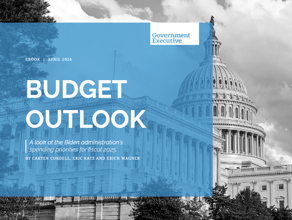Pay Will Be a Barrier to Rebuilding the Federal Workforce
The General Schedule pay system is too rigid to allow the government to attract and retain employees in today’s tight labor market.
In early 2021, U.S. workers began to resign in unusually large numbers. A record 4.4 million Americans left their jobs in September, accelerating a trend now referred to as the “Great Resignation.” Unusually tight labor markets and talent shortages are projected to continue for several years, and private sector employers are responding by offering more attractive compensation packages. “For many college-educated workers, 2021 will close with big bonus payouts and raises in sectors such as finance, law and technology,” stated a December 26 Wall Street Journal column.
Employers in every sector, including the millions of mom-and-pop businesses, understand compensation is important for attracting and retaining talent. It’s more than the pay level; employees want the assurance pay will be managed fairly. Employers committed to hiring and retaining fully qualified talent know they have to offer fair pay and benefits, an engaging work experience and career growth opportunities.
Unfortunately, the federal government’s workforce management practices have not been competitive for years and its pay system is too rigid to offer the kind of raises and bonuses necessary to compete in this new environment. That’s especially true for high demand STEM job families. To date the Biden administration has been silent on plans for the white collar salary system, except for a statement in the December pay agent report, “[W]e believe there is a need to consider major legislative reforms of the white-collar federal pay system.”
The Office of Personnel Management’s FedScope database shows there were over 600,000 federal employees age 55 and older as of September. That’s 30% of the workforce. Heavy retirements are inevitable. There is an immediate need to for federal agencies to undertake analyses and develop a plan to attract and retain talent in a tight labor market, including with improvements to pay.
Government’s Convoluted Pay Adjustments
In contrast to the market sensitive practices in other sectors, government is locked into the rigid General Schedule pay system, with its scheduled step increases. The recommended 2022 pay adjustments are based on now irrelevant Bureau of Labor Statistics data from 2020. It’s not until this coming spring that the Bureau of Labor Statistics will release its May 2021 estimates. Then, “a new estimation methodology” will obscure comparisons with previous year estimates. For unclear reasons, the bureau’s surveys ignore bonus payments, which understates the compensation of millions of employees in other sectors.
The steps leading to the 2022 pay increase for federal employees started with bureau surveys dated March 2020. The Federal Salary Council met to discuss the data in October 2020. Their recommendations were considered by the pay agent and sent to the president. In late August the White House announced the pay increase would be 2.2% with 0.5% for locality adjustments. This month, 22 months later, increases will appear in paychecks.
The pay agent’s December 2021 report noted, “the statutory formula for locality adjustments has not been followed since January 1994 because of budgetary and methodological concerns.” Budget concerns are understandable, although spending always depends on the expected payoff. Here, the budget concerns need to be balanced with the importance of rebuilding the workforce.
The methodology has been pieced together by BLS and the Office of Personnel Management over two decades. It may be that no one can explain the rationale or the steps in the analyses. The key point is that neither the Bureau of Labor Statistics nor the Salary Council can produce data showing a job is overpaid or underpaid. No other employer uses a remotely similar methodology. Further, presidents rarely provide the annual increase recommended by the pay agent.
Recent Salary Increases
In November the Government Accountability Office released a report, “Administration and Implementation of the General Schedule and Locality Pay Program,” focused on salary adjustments from 2015 to 2021. The report is not overtly critical but a comparison of the annual pay agent recommended pay increases with the actual increases makes it all too clear General Schedule salaries have fallen steadily behind.
In only one year—2020—was the pay agent’s recommended across-the-board increase accepted by a president and Congress. In the other six years the lowest pay agent recommended increase was 1.3% in 2015 and the highest a president approved was 1.4% in 2018. In five of the years the president authorized 1% or less. The authorized locality increases were less than 1% in every year except 2017 (when it was 1.1%). It’s as if the Federal Salary Council reports and data analyses did not exist.
The history of increases through the years prior to 2015 would show a very similar pattern.
There are several important factors that make the Salary Council reports and data analysis less relevant in addition to old data. First, government’s annual analysis focuses narrowly on schedule adjustments, ignoring the step increases. That understates the actual pay increases. Second, the Bureau of Labor Statistics methodology fails to focus on the employers competing with government for talent. Government contractors are an obvious group relevant to assessing federal pay. Third, BLS surveys ignore starting salaries. That makes the data useless for addressing staffing problems.
The only flexibility to respond to market developments enjoyed by federal agencies is special rate authority, but once the Office of Personnel Management approves the rates, it remains a rigid system. It’s not possible to be responsive to emerging trends.
In other sectors salary planning focuses on salary levels, not increases. Over a thousand surveys are produced every year, reporting pay data for common benchmark jobs. Salary planning is based on job-specific pay data–e.g., the starting salaries for new accountants. BLS surveys are not relevant to salary management.
Focusing on Labor Markets
The GAO report subtly highlights another issue that has been ignored. The law (5 U.S.C. § 5304) states “the boundaries of pay localities shall be determined based on appropriate factors which may include local labor market patterns, commuting patterns and practices of other employers.” Logically, the goal for all employers is to determine the pay levels needed to compete successfully for talent. However, since 1994, federal locality areas have been based arbitrarily on the metropolitan area definitions established by the Office of Management and Budget.
The metropolitan statistical areas were defined independent of the General Schedule system and are unrelated to the “appropriate factors” cited in the statute. Those factors are central to salary planning in other sectors. In the planning, employers rely on published surveys for their industry or local area and assemble data for benchmark jobs. That’s routine.
There is an argument that the current methodology used to define locality areas violates the law. Simply stated, the “appropriate factors” have been ignored. The GAO report sets the stage for that argument.
In 2022, it is likely that many employers will grant additional pay increases before the year's end. It’s happening with cybersecurity salaries. That’s basic economics—pay levels are governed by supply and demand. The pressure driving increases varies by occupation, the local availability of talent, and the circumstances affecting jobs and work environments. In health care, for example, the pandemic is obviously important.
Responsive, flexible practices were not common in 1949, when the General Schedule system was established. Employees rarely resigned to take higher paying jobs. There were no pay surveys. Other large employers at the time relied on pay programs similar to the General Schedule system. But that was almost 75 years ago. Today the system is trapped in a time warp and no longer serves government well.
The focus on the locality areas also ignores a huge geographic area— “Rest of US”—with countless labor markets. Government has thousands of employees working in locations outside of a locality area. Recent reports have highlighted the staffing problems in the Forest Service, National Park Service and the Bureau of Prisons. The common problem is that those employees work in non-urban areas and by law are paid without regard to “local labor market patterns.” That’s true as well for employees working in Defense facilities, Veterans Affairs health care facilities and Social Security offices—the list is long. Many are front-line workers.
Given the essential nature of many of these jobs, agencies should be authorized to adjust salaries as needed to keep jobs filled. The cost should be secondary to satisfying public service expectations. In large companies with multiple locations, local leaders are trusted and accountable for meeting local performance goals. Leaders work with their HR managers to develop local pay programs. Managing pay is basic to workforce management
Government cannot afford to treat the General Schedule pay system as sacrosanct. Gen Z job seekers are not lining up for jobs. Turnover is costly. Heavy retirements are inevitable. The competition for scarce skills is surging. The General Schedule system is a barrier to rebuilding the workforce.






